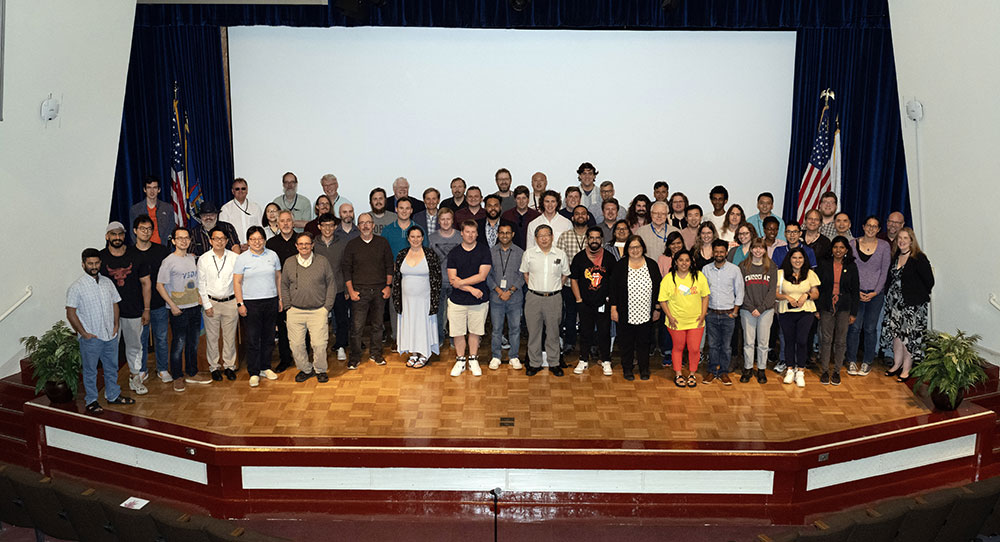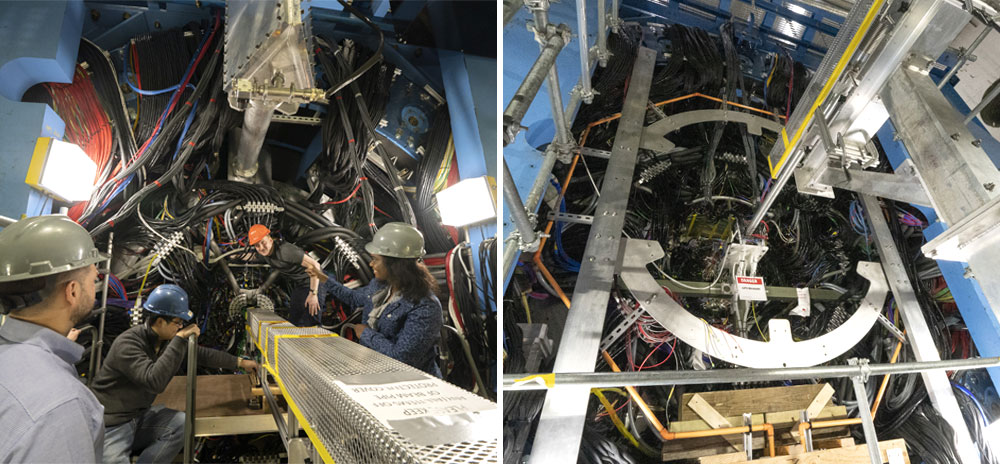Celebrating New Beginnings at RHIC and EIC
Annual RHIC & AGS Users' Meeting highlights productive programs, response to challenges, and forward-looking physics goals
August 31, 2023
By Kelly Zegers and Laura Mgrdichian-West
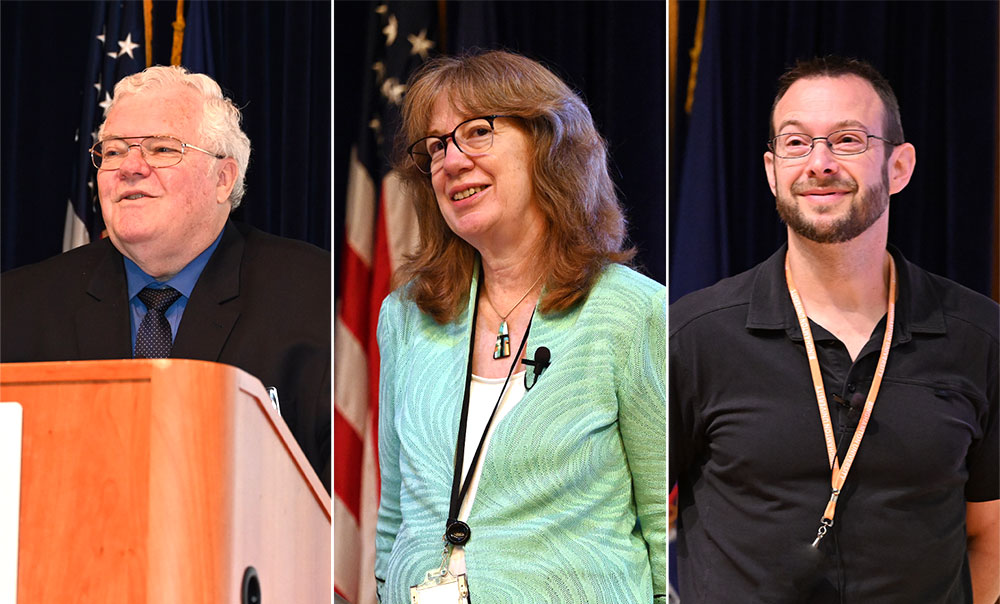 enlarge
enlarge
Pictured from left to right: Timothy Hallman, DOE's Associate Director of the Office of Science for Nuclear Physics, Brookhaven Laboratory Director JoAnne Hewett, and RHIC Run 23 Coordinator Travis Shrey.
Scientists who conduct research at and operate the Relativistic Heavy Ion Collider (RHIC) and its pre-injector accelerator, the Alternating Gradient Synchrotron (AGS), gathered August 1-4, 2023 for a hybrid annual users’ meeting hosted by the U.S. Department of Energy’s (DOE) Brookhaven National Laboratory.
This year’s RHIC & AGS Users’ Meeting highlighted the latest results and other news from RHIC’s PHENIX, sPHENIX, and STAR experiments. It also provided an outlook for future programs and further operations at RHIC—a DOE Office of Science user facility for nuclear physics research at Brookhaven Lab—and the upcoming Electron-Ion Collider (EIC), a next-generation facility Brookhaven is building in partnership with DOE’s Thomas Jefferson National Accelerator Facility.
While RHIC collides two beams of atomic nuclei to recreate the conditions of the early universe, the EIC will collide electrons with nuclei to explore the building blocks of matter as they exist in the atoms that make up our world today.
“This is really an exciting time for the Laboratory and for you, the users of these colliders,” said Brookhaven’s new laboratory director, JoAnne Hewett. “The EIC will be the only collider built at any laboratory worldwide for the next two decades. That’s real opportunity and real excitement for this community. I couldn’t be more excited to be here to help make this happen.”
Attendees also heard the latest on RHIC Run 23, which rang in a new era with the commissioning of sPHENIX, the first new detector built at RHIC since it began operating in 2000, as well as first use of all major upgrades to the STAR detector. As reported, both detectors are making progress toward goals outlined in the 2015 Long Range Plan for Nuclear Science, a roadmap that guides U.S. research in the field. But the run did end ahead of schedule due to a leak in the helium system used to cool electrical components of the collider (more on that below).
Celebrating success
Haiyan Gao, Brookhaven’s Associate Laboratory Director for Nuclear and Particle Physics, who oversees the RHIC research program, shared science highlights and noted that there is much to celebrate:
“In the last year, there has been enormous progress in science,” Gao said. “I’m impressed by the scientific productivity of our scientific collaborations, our scientists, students, and postdocs.”
Looking ahead, Gao acknowledged budget challenges in sight for RHIC’s final runs. But she emphasized the importance of completing RHIC’s science mission—with strong support from DOE’s Office of Nuclear Physics to do so—as the facility transitions to the EIC. A detailed transition plan is in the works, she said.
Gao also noted that RHIC’s science mission does not end with the wrap-up of its data-taking operations. Researchers including many students will be analyzing data taken by PHENIX, sPHENIX, and STAR and using it to make discoveries for many years.
“The RHIC data will have a major impact in science and in some cases will inform EIC science,” Gao said. She also noted how RHIC “provides an important, talented workforce for the future EIC and other related areas.”
RHIC Run 23 Update
When atomic nuclei collide at RHIC’s high energies, protons and neutrons “melt” to free matter’s fundamental building blocks—quarks and gluons—and briefly create quark-gluon plasma (QGP). QGP is an exotic form of nuclear matter that existed for a brief instant just after the Big Bang, some 14 billion years ago—before protons, neutrons, and atomic nuclei first formed.
This year, accelerator physicists and operators were tasked with delivering collisions between beams of gold ions traveling at nearly the speed of light so scientists could capture collision snapshots for two experiments investigating QGP and more: sPHENIX and STAR.
The last time operations staff ran two experiments with high-intensity beams at the same time with full energy was in 2016, said RHIC Run 23 Coordinator Travis Shrey. He noted that this year’s run stirred up technical twists and turns right off the bat.
“It was challenging,” he said.
After fine-tuning equipment and coordinating staff to reach normal RHIC operations for both experiments in the run’s first several weeks, the sweltering summer heat hit.
RHIC’s operators knew a summer run would be tricky.
For one thing, RHIC’s superconducting magnets have to be kept super cold with a flowing bath of liquid helium. That allows the electronic circuits that power the magnets to operate without resistance to keep beams circulating and colliding.
In addition, the facility’s power supplies can be finicky in the heat. They typically experience intake air of, at most, 85 degrees Fahrenheit, Shrey said. But this summer, some components saw temperatures reach 95 degrees, and at one point over 110 degrees.
Another challenge: “During the summer on Long Island, you get lots of thunderstorms, so there are going to be power dips,” Shrey said. “Our equipment does not like getting slammed off at maximum operating power.”
The unfortunate, but expected, result of heat-related power dips resulted in periods of the run, sometimes full days, where no physics data could be recorded.
In addition, the recent Canadian wildfire smoke that shrouded the region also impacted STAR’s data-taking. The Lab decided to shut down all high-sensitivity smoke detectors, and therefore STAR, for one day because the wildfire smoke could trigger them.
“Even with all of that, though, we still had tremendous progress,” Shrey said. He noted that at the time of the meeting, sPHENIX’s commissioning was on schedule and STAR had been on track to hit their data-taking goal.
Then, an unexpected helium leak from a valve box in RHIC’s cryogenics/main power supply service building halted operations on August 1. After exploring options, the team determined the time for repairs would take at least four weeks—too far into the calendar to warrant continuing the RHIC run as scheduled.
At the meeting, Hewett stressed that, “the Laboratory is committed to deliver the full promised science program for RHIC operations.” Remarking on the shutdown in mid-August, she noted that, “The repair plan and the long-term goals for research at RHIC are best served by a prudent approach. This approach will allow us to begin the repair and the planned shutdown so that we can start earlier with Run 24 next year.”
Hewett, Shrey, and others commended operations staff from the Collider-Accelerator Department (C-AD) for their expertise and responsiveness to all of these issues.
“We now have a full staff of operators who can do anything to this machine,” Shrey said.
sPHENIX's first run
Despite the setbacks brought on by a challenging run, RHIC’s newest detector brought good news. Start-up of sPHENIX, a detector equipped to capture 15,000 particle collisions per second to help characterize the inner workings of QGP, was the highest priority of the run.
Gao characterized the commissioning and calibration phase as an overall “extreme success” to the point of the shutdown. All sPHENIX subsystems had taken RHIC data that is now stored in its high-performance storage system—a Run 23 highlight.
“I would like to thank everybody for your hard work [commissioning sPHENIX]—the collaboration and C-AD and many others who contributed,” Gao said.
Stefan Bathe, a Baruch College professor and sPHENIX collaboration physicist, recapped the effort it took to make the project a reality. He contrasted a photo of the detector taken last year, showing its just-installed outer hadronic calorimeter surrounding a massive cylindrical magnet, with a recent photo showing the drum of the magnet filled with a slate of sophisticated subdetectors and electronics that crews had meticulously tested and installed.
“This was an amazing feat … to start our inaugural run,” he said.
Bathe also mentioned that lots of young scientists are a part of the sPHENIX effort. And he thanked C-AD and all the tradespeople involved and said they have been “valuable in this extremely challenging environment.”
The users’ meeting also hosted an entire day of workshops focused on jets and heavy ‘flavor’ quarks, two of the physics areas sPHENIX’s measurements will explore in detail.
STAR upgrades in action
A major charge of the STAR physics program is to map the phase diagram of nuclear matter and to explore the workings of quantum chromodynamics (QCD)—the theory of interactions between subatomic quarks and gluons. Physicists use RHIC data to search for signs of transitions between different phases of nuclear matter, including quark-gluon plasma and the protons and neutrons that make up ordinary atomic nuclei.
“After 20 plus years we’re getting very close to understanding strongly interacting QCD and we have made so many discoveries at RHIC. To take one step further, we are trying to go into the precision frontier,” said Brookhaven Lab STAR physicist Kong Tu.
Recent upgrades at STAR were in use with top-energy gold-gold collisions for the first time in Run 23. These include STAR’s forward detectors, Tu said. And since mid-June, STAR made use of an exciting, fully functional readout upgrade allowing it to capture up to 5,000 collision events per second—more than double its rate in any previous year.
“This is a huge improvement for RUN 23 STAR data-taking,” Tu said.
STAR’s goal for RHIC Runs 23 through 25 is to collect data from 20 billion minimum bias events.
“As of today, we have recorded 6.5 million minimum bias events,” Tu said. “We have really been doing a good job of recording all of the data that we want.”
Physics highlights from STAR, PHENIX
PHENIX and STAR physicists also reported on published and preliminary results based on data captured in previous runs. Just a few of these recent physics highlights include:
- New evidence that QGP production in gold nuclei collisions can be “turned off” by lowering the collision energy
- A new way to use RHIC to see the shape and details inside atomic nuclei
- New evidence that gluons reach a steady “saturated” state inside the speeding ions
Brookhaven physicist Rachid Noucier presented the most recent highlights from PHENIX, which collected data from 2000 to 2016. He noted that RHIC is an “amazing QCD machine” and that physicists continue to analyze data from PHENIX and publish results. Most recently, analyses have focused on data captured from 2012 to 2016.
The collaboration’s presentations included discussions of:
- Spin physics: evidence that the spins of gluons align with the spin of the proton they are in
- Particle flow results as evidence of QGP drops in small collision systems, with some contrasts between data from PHENIX and STAR
Notes from funding agencies
RHIC and EIC operate with funding allocated by Congress and the DOE Office of Science. Individual RHIC users may also receive funding from the National Science Foundation (NSF). Talks given by members of these funding agencies are always a highlight of the RHIC & AGS Users’ Meeting.
Timothy Hallman, DOE’s Associate Director of the Office of Science for Nuclear Physics (NP) outlined three priorities from his office’s perspective: new knowledge and technology for nuclear physics research and development; training a diverse “nuclear literate” workforce with specialized skills; and bettering lives through a range of nuclear physics applications—from medical diagnosis tools, to research that supports deep space exploration, to national security, and fire safety.
Running RHIC and the future EIC can contribute to all of these areas of importance to our nation—and bring in the expertise of collaborators from around the world.
Hallman remarked how the EIC is international at its core, with 36 countries that have scientists interested in participating in its research because of that machine’s remarkable potential for discovery.
“We’re at a point in the history of science comparable to the time in the [last century] when people like Einstein and Bohr and Rutherford were trying to figure out how an atom was structured and how it behaved, and it was completely unknown,” he said. “The knowledge that came out of those studies, you could make the argument, is responsible for all the modern things we currently use and enjoy. [With the EIC,] we’re on the precipice of doing the same for the interior of the proton. There may be remarkable things to unfold.”
On the numbers, Hallman shared that the President’s budget request, the House Mark, and the Senate Mark all point to $98 million for the EIC’s fiscal year 2024 (FY24) allocation. While acknowledging that more funding is needed, he noted that, at a moment when budgets are constrained, “The fact that they’ve all agreed on this number for the Electron-Ion Collider says, in some ways, the Electron-Ion Collider is being protected.”
Overall, the EIC project is moving along well, Hallman said. But for a project with a top-line projection of $2.8 billion, “you have to stay on top of every minute of every day.”
Last year, the EIC project at Brookhaven Lab received $105 million, plus $33 million allocated to Jefferson Lab for work toward the facility, as part of the Inflation Reduction Act. Hallman called that funding support a game changer.
But the Office of Science’s current FY24 budget projection is not as rosy. It will allow NP national user facilities to operate at or above 90% of optimal funding. That’s not sufficient for the number of weeks hoped for in RHIC Run 24, Hallman said, but it’s a recognized problem that he is working on.
Several speakers noted that the run time in FY24 is essential to produce proton-proton and proton-gold collision data for comparison with results from this year’s and FY25’s planned gold-gold runs using sPHENIX.
Kenneth Hicks, the DOE NP program manager for heavy ion physics, said the program’s research budget remains challenging over the previous year, but the best proposals will continue to be funded. Even so, the field is exciting and vibrant, he said.
“Keep up the good work,” Hicks told meeting attendees. “For many metrics we’re doing great and I’m going to keep fighting for you as program manager.”
Hallman noted NP’s recent successful efforts to increase representation of minority communities in nuclear physics, including traineeships that recruited 110 students, many from minority serving institutions. Half of the students awarded traineeships went on to pursue graduate degrees in science or engineering, he said.
“We in the Office of Science, Office of Nuclear Physics, are strongly vested in enhancing diversity, equity, and inclusion in our community, and in science in general,” Hallman said. He noted that Brookhaven’s pilot traineeship program was one of the most successful initiatives.
NSF has also been tracking efforts and legislation focused on diversity, equity, inclusion, and accessibility (DEIA). That agency is developing tools to assess underrepresentation and barriers, said Charles Barber, NSF chief diversity officer, during a workshop that covered DEI issues, initiatives, and overviews on how to foster inclusive environments.
NSF’s strategies focus on shifting performative DEIA to a more enduring cultural intelligence, Barber said.
Electron-Ion Collider
At a session devoted to the EIC, James Yeck, Brookhaven’s Associate Laboratory Director and Project Director for the EIC, briefed meeting attendees on the status of the EIC project.
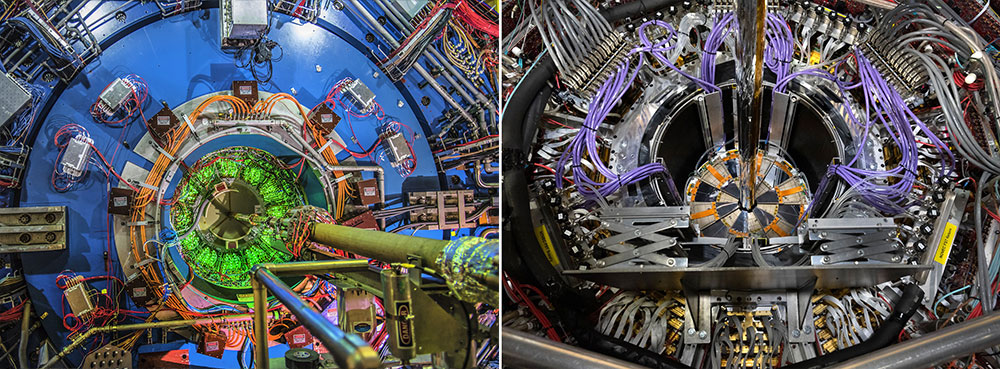 enlarge
enlarge
Recent upgrades at STAR were in use with top-energy gold-gold collisions for the first time in Run 23
“The EIC is one of the most challenging and exciting accelerator complexes ever [to be] built, and the only accelerator being built in the next decade,” he said.
As such, he explained, the EIC is growing into a fully international effort, with the organization and advisory committees being populated by scientists from across the globe. He presented the rigorous schedule of EIC design reviews and decisions. Some recent accomplishments include signing a contract for infrastructure-related architecture and engineering services, increased accelerator staffing and collaborations with U.S. and international institutions, and the selection of detector technology and design choices by the EIC’s first physics program, the Electron-Proton/Ion Collider (ePIC) experiment.
Yeck also laid out some of the many challenges that will be faced, including securing additional DOE funding and the “incredibly important” task of keeping to the design and construction schedule. The next key milestone is reaching level CD-3A in January of 2024, which will allow for some pre-construction activities to take place, such as certain site preparation tasks and procurement of long-lead-time items needed to build the machine.
The EIC project has held three major meetings so far, and the EIC Users Group most recently convened July 24-31 at the University of Warsaw (Poland). Upcoming EIC events include two workshops: “Precision QCD Predictions for ep Physics at the EIC (II)” and “Probing the Frontiers of Nuclear Physics with AI at the EIC,” being held September 22-23 and 25-26, respectively, at Stony Brook University.
Daniel Brandenburg of The Ohio State University, then talked about the ePIC detector.
“Everything we want the EIC to be is guided by big, important questions in quantum chromodynamics, and we need to work backwards to figure out how to address those questions and build an experiment to answer them,” he said. “The whole EIC physics [program] must be addressed by ePIC.”
The ePIC detector will have to perform many jobs, including particle tracking and identification, and a full suite of calorimetry functions. It will also include complex data acquisition and electronic readout systems. The last year saw great progress for the ePIC collaboration, with many new collaborators and organizers on board, and decisions made for how to consolidate and optimize the detector layout.
Campus update, awards, and election results
Finally, meeting attendees heard about exciting changes coming to the Brookhaven campus from Steve Cannella, the manager of the lab’s Campus Development office. The new Science and User Support Center, which will be a welcome center for the Lab’s thousands of guest and user scientists, is under construction as of April of last year. The center is one element of the planned Discovery Park, a sweeping 60-acre gateway to Brookhaven that will include new offices, research and development spaces, housing, and food/amenities. In addition, the Lab will re-open an on-site childcare facility with a new provider at the start of September, Gao announced.
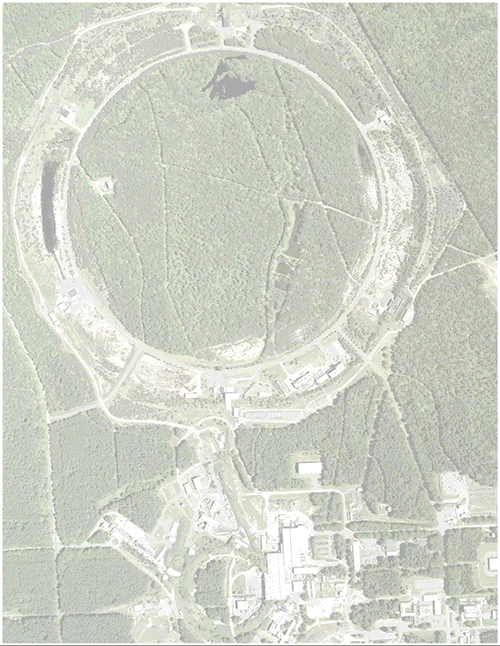 enlarge
enlarge
This schematic shows the chain of accelerators that feed beams of ions into the two rings that make up the 2.4-mile-circumference Relativistic Heavy Ion Collider (RHIC), and how RHIC will be transformed into an Electron-Ion Collider (EIC) by adding components for accelerating and colliding electrons with ions.
Throughout the meeting, speakers extended thanks to the staff in Brookhaven’s Guest, User & Visitor Center, topical workshop organizers, and presenters for their time and contributions to the four-day event.
They also celebrated Ph.D. students and scientists recognized by the User’s Executive Committee (UEC) for outstanding thesis and research in either theory or experiment related to RHIC, the AGS, NASA Space Radiation Laboratory, Tandem Van de Graaff, Accelerator Test Facility, Brookhaven Linac Isotope Producer, and/or EIC facilities. View the results of the merit awards and thesis awards online.
Additional awards and election results included:
Best Poster
The Effects of a Passive Bi-Polar Grid on Position Resolution by Vladislav Zakharov from Stony Brook University
UEC Elections
The UEC represents nearly 900 experimental physicists across PHENIX, sPHENIX, and STAR experiments.
UEC Chair-Elect: Anders Knospe, Lehigh University
Student/Postdoc Members:
- Yu Hu, Lawrence Berkeley National Lab
- Tristan Protzman, Lehigh University
- Krista Smith, Los Alamos National Lab
General Members:
- Ross Corliss, Stony Brook University
- Christine Nattrass, University of Tennessee, Knoxville
- Maya Shimomura, Nara Women's University
Research at RHIC and the facility’s operations, the sPHENIX upgrade, and the EIC project are all funded by the DOE Office of Science, with additional contributions from NSF towards sPHENIX, STAR, and the research at RHIC.
Brookhaven National Laboratory is supported by the Office of Science of the U.S. Department of Energy. The Office of Science is the single largest supporter of basic research in the physical sciences in the United States and is working to address some of the most pressing challenges of our time. For more information, visit science.energy.gov.
Follow @BrookhavenLab on social media. Find us on Instagram, LinkedIn, Twitter, and Facebook.
2023-21387 | INT/EXT | Newsroom




